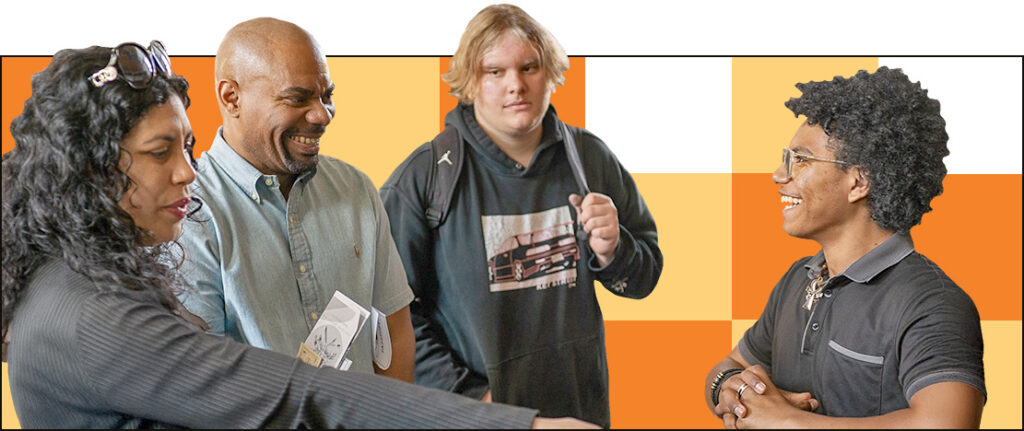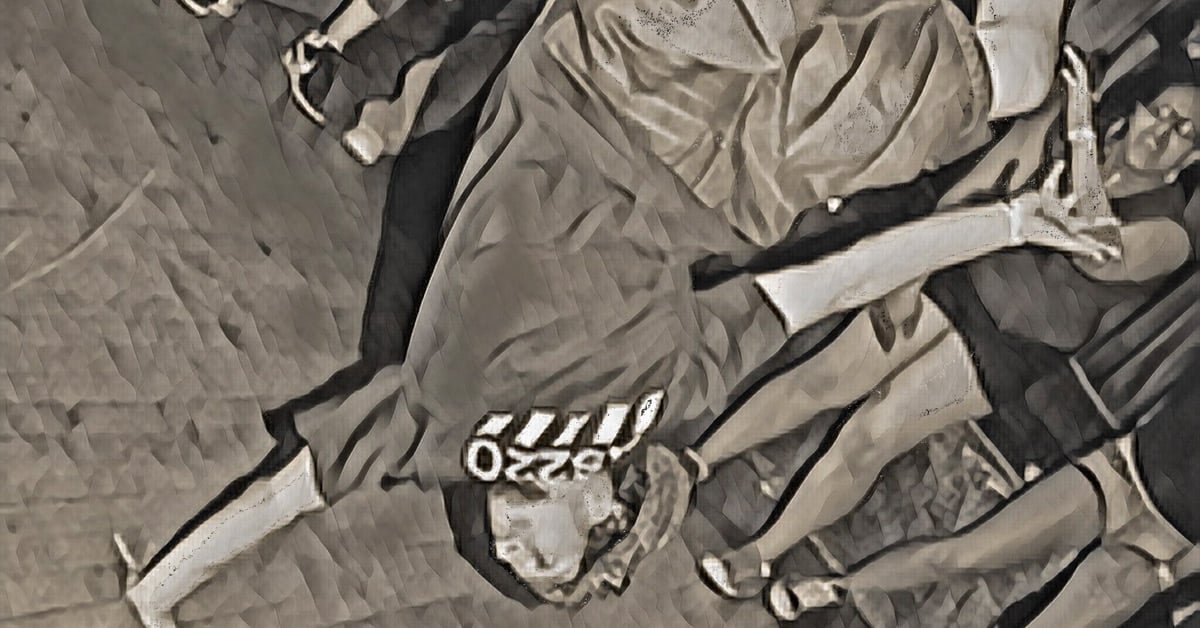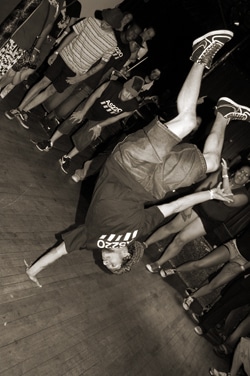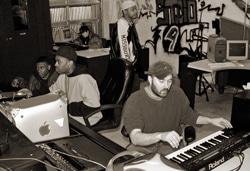


learn more about

learn more about

overview
partner with us
partner with us
events

events



learn more about

learn more about












A TV satellite dish made of tin cans. A tattoo gun crafted out of a ballpoint pen and a rubber band. Turntables and speakers plugged into a streetlamp to power music for a block party. Growing an innovative alternative high school out of a professional recording studio…
These are examples of what my colleagues and I call “Hip Hop Genius,” by which we mean: creative resourcefulness in the face of limited resources. Or as it is often said in the hip hop community: flipping something outa nothing. When we use the term hip hop, we’re not just talking about music—or music, graffiti, and dance (which are considered central elements of hip hop culture). We’re referring to the unique blend of instincts, confidence and ingenuity that develop in oppressed communities, as has been superbly demonstrated through the evolution of hip hop culture over the last thirty years.
“Can you teach people to be more creative?” someone once asked the philosopher, Nelson Goodman. “Yes,” he answered. When asked how, he replied, “Give them harder problems.” Faced with racism, classism, ageism, and other forms of structural subjugation—instead of breaking down and giving in to stereotypes and statistics—young people have developed new forms of art and business as well as the audacity to believe they can do something that’s never been done. This is Hip Hop Genius.
Educators often view hip hop as a negative influence in students’ lives. As far as many teachers are concerned, hip hop music promotes violence, misogyny, homophobia, hyper-capitalist consumption, and—to add insult to injury—bad grammar! Hip hop culture is seen as a force that competes for students’ attention, which frustrates many teachers who invest time and energy attempting to engage students, only to be drowned out by cultural products that often critique the very values schools are trying to instill.
Layers of racism, classism and ageism also factor into educators’ frustration with a medium created predominantly by young Black and Latino people from low-income communities—a medium that is wildly successful at engaging the very students schools struggle to reach. It is this disjunction between the achievements young people have experienced through hip hop culture and the failure of schools to fulfill the responsibility of engaging these same young people that has drawn me to study hip-hop education.
Many hip hoppers now have the skills, credentials and resources to influence what goes on in schools. And other educators are ready to engage with hip hop. But what should this engagement look like? On the most basic level, it could mean looking at hip hop as an art form and studying its history and content. But for those of us who understand hip hop’s essence to be a perfect storm of ingenuity, chutzpah and style—as exemplified by disenfranchised teenagers siphoning electricity from streetlights and manipulating audio equipment to create an entirely new genre of music—the question becomes, how can we embrace and embody those innovative instincts in the field of education?
For the last five years, I have worked with a school where hip hop reigns. The High School for Recording Arts (HSRA) in St. Paul, Minnesota has been dubbed “Hip Hop High” because of its deep embrace of hip hop culture and its innovative approach to education. The school—founded by a professional rapper, who grew it organically out of a recording studio—has developed to incorporate proven practices from the music industry, the hip- hop community and the field of alternative education. In what follows, I will share a few elements of the school that exemplify the creativity and swagger of Hip Hop Genius. My hope in sharing these examples is to engender thoughtful dialogue about hip hop’s potential implications for pedagogy, school design and leadership.
HSRA educators honor each student’s brilliance by encouraging students to develop independent projects, for which they receive academic credit. Allowing students to play such an active role in their education demonstrates confidence in students’ ability to take responsibility for their own learning. Advisors help students identify project topics and develop timelines, but it is ultimately the students who determine how much they learn, and consequently, how much credit they will receive (staff assign credits based on the knowledge and skills students are able to demonstrate upon completion of a project).
Hip hop took classical dance, flipped it on its head and literally spun it around. Project-based learning does the same thing to traditional schooling. There is no set curriculum. No rows of seats with a teacher standing at the front. No multiple choice tests. Students are doing work that is relevant and real to them. They do not receive credits for sitting quietly through lessons. As is customary in hip hop, each student must “show and prove,” demonstrating their new knowledge and skills. Students’ projects are not only a personal learning experience, but also a learning opportunity for their community, as they share new understandings through project presentations.
My point here is not that HSRA invented project-based learning—this style of learning has existed for many years and is a prominent part of several other school designs. What excites me is that, like hip hop producers who select samples of old music and loop and layer them to create a new composition, the hip hop educators at HSRA have looked at a variety of traditional and alternative methods, sampled aspects of several and added their own flavor.
By starting and cross-promoting their own record labels, media outlets, clothing brands, fragrances and beverage companies, hip hop artists have crafted a fresh approach to the art of business. HSRA has followed this lead, structuring deals with several companies, as well as state departments of health and education, to provide student-produced music and materials that are effective at reaching other young people with important messages. While students are responsible for creating the music, they also learn about the business of music through a workshop led by the school’s Development Director, Tony Simmons, who was formerly an entertainment lawyer.
HSRA has also entered an innovative partnership with the graffiti-artist-turned-urban-fashion-mogul, Mark Ecko. As one of the first schools in the nation to partner with Marc Ecko Enterprises, a company that owns six multi-million dollar clothing brands, HSRA has put students in contact with top designers in the fashion industry. HSRA students, many of whom wear Ecko clothing, are enlisted to design products for Ecko and receive feedback on their work (via videoconference) from Ecko designers. Ecko gains an authentic young, hip perspective on design, while students gain experience and, if their designs are taken to market, a share of the profits.

The rigidity of schedules and course requirements makes this type of program difficult to imagine in traditional schools. But just as hip hop artists have broken barriers between the music business and several other industries, hip hop educators can embrace this spirit of entrepreneurial collaboration to provide their students with valuable opportunities for authentic work experiences, career exploration and engaging connections to academic content.
Over the course of their tenure at HSRA, many students participate in the “Urban Music” workshop facilitated by Darryl Young, a certified Special Education teacher, and Phil Winden, a professional studio engineer and educator. Urban Music teaches participants audio production skills, while also diving into issues that affect students’ lives and communities. Past Urban Music groups have produced compilation albums on topics ranging from homelessness to HIV awareness. These high quality, mass-produced albums are distributed to audience members of all ages. The songs on each compilation offer multiple viewpoints on the topic students are addressing and represent research they have conducted, as well as their personal experiences and perspectives. These songs serve as words of inspiration and sometimes warning for their peers, while also giving outsiders a glimpse at some of the challenges they face.
In addition to the obvious connection to hip hop through the songs that are produced in Urban Music, the workshop also carries on the hip hop tradition of critically addressing social injustices. While hip hop has always included party music, it has also always told stories of experiences that were not being represented in mainstream media. Urban Music carries on this legacy, teaching students how to make their songs sound good, but also instilling a level of consciousness and responsibility around the message of their music.
The set up of the physical environment in which learning occurs is so important that constructivist educators at the famous Reggio Emilia preschools in Italy speak of space as one of the teachers. The first time I walked into a Reggio school, before I saw any teaching or learning, I noticed beautiful furniture, sculptures, costumes and art materials and knew I was in a place of curiosity, discovery, and joy. Similarly, HSRA’s facility itself communicates a powerful message. From blank CDs being sold from vending machines in the school’s cafeteria to halls lined with posters of albums that have been produced at the school, there are many visual cues that HSRA is a hip hop school. The most obvious indication is the school’s physical layout. When you walk into HSRA, you immediately see two professional recording studios. Red “In Session” lights over the doors are the first indication that these are serious studios. Inside, everything—from the soundproofed vocal booths to the state of the art computers—drives the point home. The leather sofas and dark lighting provide the finishing touches.
Not only are the studios the first thing students see when they enter the school, the rest of the school’s space is wrapped around the studios. They are literally at the center of the facility. This sends an important message. The academic program reinforces the point as workshops like Urban Music meet each day in the studio. Of course not every school should be built around recording studios. The larger significance of HSRA’s layout is that the architectural design is intentional in the way that it welcomes students and communicates the school’s purpose.
Respecting students means not only embracing music and culture, but also working hard to cultivate conditions that honor their realities and foster success. For instance, HSRA has struggled with chronic tardiness. In addition to implementing consequences that discourage students from being late, the staff has gone to great lengths to understand the problem and generate innovative solutions, one of the most fruitful of which was to start the school day at 10am—later than almost any other high school in the country. The school came to this solution organically through experience and dialogue, but research has demonstrated that later school hours are actually more in line with teenagers’ natural circadian rhythms.
The school day at HSRA runs later than most schools, officially ending at 4:30pm, with many students and staff members staying later to work on school projects, pursue personal endeavors, and hang out. Given that most arrests of teenagers occur during weekday afternoons, keeping the school open during these times helps students stay productive and avoid dangerous situations.
Many hip hop artists intentionally “leak” tracks from upcoming albums to get a feel for listeners’ reactions, returning to the studio to make any needed changes. To be successful, innovative schools must exercise this kind of responsive flexibility by listening to their audience—students—and breaking conventions to implement creative solutions.
“TC is a straight up hood cat,” an HSRA alumnus told me with great affection in his voice. The former student was referring to the school’s leader, David “TC” Ellis’s proximity to street culture, as well as to particular stretches of concrete that pave HSRA students’ realities. Born and raised in the Twin Cities (hence his acronym), TC has overcome many challenges, including struggling as a student and battling a drug addiction. These experiences give TC a firsthand understanding of challenges faced by many HSRA students and families. While not a lot of principals have this history, every school leader can take on the responsibility of serving as a bridge between community and school.
TC’s credibility extends into the recording studio. He was a rapper with a record deal on a major label. One day when I was visiting HSRA, a friend of TC’s brought the famous rapper and actor, Ice Cube by to check out the program and talk with the students. During a school assembly, Ice Cube shared the stage with several HSRA students and rapped over a beat by a live student band. TC also grabbed the mic and kicked some of his lyrics. A student near me shouted, “That’s my principal!!!”
TC has personal relationships with so many people in the local community that when I ask students why their performance at HSRA is so different from lackluster efforts at past schools, one of the many reasons I have heard repeatedly is, “I know TC’ll call my mother” (or grandmother, or other family member). TC’s relationships throughout the community also come into play when gang violence threatens HSRA. TC calls local gang leaders and enlists their help in keeping the school safe. There are few principals who have these kinds of relationships. Students see TC’s ability to navigate these two worlds and realize that the world of school doesn’t have to be as separate from their other realities as they once believed.
The more students feel respected and engaged, the more likely they are to succeed and to want to “give back” after they graduate. I brought a friend on a recent visit to HSRA and the first six people she met were former students who are now staff members. Regardless of their positions at the school, which range from advisors to studio technicians to security guards, these staff members are role models for students and help extend the culture of authenticity. Some students for whom HSRA has been a turning point have a deep desire to provide similar experiences for future generations of students. It is alumni like these who will keep the school hip, relevant and constantly innovative as it moves into the future.
This is Hip Hop Genius. And this is what we need more of. Thirsty young hustlers ready to remix the educational equation. Not just altering the content of a traditional academic structure, but building institutions that are fundamentally more responsive to young people’s ingenuity, interests and needs. Creating schools that not only teach hip hop, they are hip-hop.
To learn more about Sam Seidel’s work and research, visit
https://www.samseidel.is/